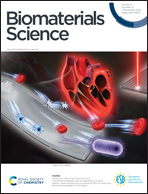NIR-II FL/PA dual-modal imaging long-term tracking of human umbilical cord-derived mesenchymal stem cells labeled with melanin nanoparticles and visible HUMSC-based liver regeneration for acute liver failure†
Abstract
Acetaminophen (APAP) has been widely used for relieving pain and fever, whilst overdose would lead to the occurrence of acute liver failure (ALF). Currently, few effective treatments are available for ALF in clinic, especially for severe, advanced- or end-stage patients who need liver transplantation. Human umbilical cord-derived mesenchymal stem cells (hUMSCs), as one of the mesenchymal stem cells, not only contribute to relieving hepatotoxicity and promoting hepatocyte regeneration due to their self-renewing, multi-differentiation potential, anti-inflammatory, immunomodulatory and paracrine properties, but possess lower immunomodulatory effects, faster self-renewal properties and noncontroversial ethical concerns, which may play a better role in the treatment of ALF. In this work, hUMSCs were rapidly labeled with near-infrared II fluorescent dye-modified melanin nanoparticles (MNP-PEG-H2), which could realize long-term tracking of hUMSCs by NIR-II fluorescent (FL)/photoacoustic (PA) dual-modal imaging and could visualize hUMSC-based liver regeneration in ALF. The nanoparticles exhibited good dispersibility and biocompatibility, high labeling efficiency for hUMSCs and excellent NIR-II FL/PA imaging performance. Moreover, the MNP-PEG-H2 labeled hUMSCs could be continuously traced in vivo for up to 21 days. After intravenous delivery, the NIR-II FL and PA images revealed that labeled hUMSCs were able to engraft in the injured liver and repair damaged tissue in ALF mice. Therefore, the hUMSCs labeled with endogenous melanin nanoparticles solve the key tracing problem of MSC-based regenerative medicine and realize the visualization of the treatment process, which may provide an efficient, safe and potential choice for ALF.



 Please wait while we load your content...
Please wait while we load your content...